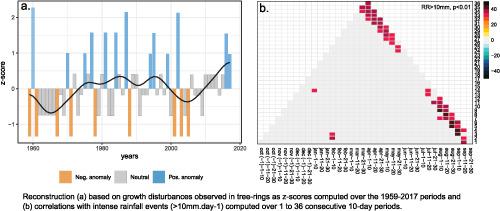当前位置:
X-MOL 学术
›
Earth Surf.Process. Land.
›
论文详情
Our official English website, www.x-mol.net, welcomes your
feedback! (Note: you will need to create a separate account there.)
Dating of rockfall damage in trees yields insights into meteorological triggers of process activity in the French Alps
Earth Surface Processes and Landforms ( IF 2.8 ) Pub Date : 2020-05-28 , DOI: 10.1002/esp.4876 R. Mainieri 1 , C. Corona 2 , J. Chartoire 3 , N. Eckert 3 , J. Lopez-Saez 4, 5 , M. Stoffel 4, 5, 6 , F. Bourrier 3
Earth Surface Processes and Landforms ( IF 2.8 ) Pub Date : 2020-05-28 , DOI: 10.1002/esp.4876 R. Mainieri 1 , C. Corona 2 , J. Chartoire 3 , N. Eckert 3 , J. Lopez-Saez 4, 5 , M. Stoffel 4, 5, 6 , F. Bourrier 3
Affiliation

|
Rockfall release is a rather unpredictable process. As a result, the occurrence of rockfall often threatens humans and (infra)structures. The assessment of potential drivers of rockfall activity therefore remains a major challenge, even if the relative influence of rainfall, snowmelt, or freeze–thaw cycles has long been identified in short‐term monitoring projects. In the absence of longer‐term assessments of rockfall triggers and possible changes thereof, our knowledge of rockfall dynamics remains still lacunary as a result of the persisting scarcity of exhaustive and precise rockfall databases. Over the last decades, several studies have employed growth disturbances (GDs) in tree‐ring series to reconstruct rockfall activity. Paradoxically, these series were only rarely compared to meteorological records. In this study, we capitalize on the homogeneity of a centennial‐old reforestation plot to develop two reconstructions – R1 including only growth suppressions, and R2 based on injuries – with limited biases related to decreasing sample size and changes in exposed diameters back in time. By doing so, our study also and quite clearly highlights the large potential that protection forests have in terms of yielding reliable, multidecadal rockfall reconstructions. From a methodological perspective, we find no synchronicity between R1 and R2, as well as an absence of meteorological controls on rockfall processes in R1. This observation pleads for a careful selection of GDs in future reconstructions. In terms of process dynamics, we demonstrate that summer intense rainfall events (>10 mm day−1) are the main drivers for rockfall activity at our study site. Despite the stringency of our detection procedure, correlations between rockfall activity and meteorological variables remain comparable to those reported in previous studies, as a result of the complexity and multiplicity of triggering factors. We therefore call for a more systematic coupling of tree‐ring analysis with rockfall and microclimatic monitoring in future studies. © 2020 John Wiley & Sons, Ltd.
中文翻译:

树木中落石损坏的日期可让您深入了解法国阿尔卑斯山过程活动的气象触发因素
落石释放是一个相当不可预测的过程。结果,落石的发生常常威胁到人类和(基础)结构。因此,即使长期以来在短期监测项目中已经确定了降雨,融雪或冻融循环的相对影响,对落石活动潜在驱动因素的评估仍然是一项重大挑战。在缺乏对崩塌触发因素及其可能变化的长期评估的情况下,由于详尽而精确的崩塌数据库的持续缺乏,我们对崩塌动力学的认识仍然是空洞的。在过去的几十年中,几项研究采用了树环系列中的生长扰动(GDs)来重建落石活动。矛盾的是,这些系列很少与气象记录相提并论。在这个研究中,我们利用一个拥有百年历史的重新造林地块的同质性来开发两个重建项目-仅包括生长抑制的R1和基于伤害的R2-在减少样本量和及时改变暴露直径方面存在有限的偏差。通过这样做,我们的研究也非常清楚地突出了防护林在产生可靠的,多年代际的落石物重建方面的巨大潜力。从方法论的角度来看,我们发现R1和R2之间没有同步性,并且在R1中没有对落石过程的气象控制。该观察结果建议在将来的重建中仔细选择GD。在过程动力学方面,我们证明了夏季强烈降雨事件(> 10 mm天 和R2(基于伤害)–与减小样本大小和及时改变裸露直径有关的有限偏差。这样一来,我们的研究也很清楚地突出了防护林在产生可靠的,多年代的落石物重建方面的巨大潜力。从方法论的角度来看,我们发现R1和R2之间没有同步性,并且在R1中没有对落石过程的气象控制。该观察结果建议在将来的重建中谨慎选择GD。在过程动力学方面,我们证明了夏季强烈降雨事件(> 10 mm天 和R2(基于伤害)–与减小样本大小和及时改变裸露直径有关的有限偏差。这样一来,我们的研究也很清楚地突出了防护林在产生可靠的,多年代的落石物重建方面的巨大潜力。从方法论的角度来看,我们发现R1和R2之间没有同步性,并且在R1中没有对落石过程的气象控制。该观察结果建议在将来的重建中谨慎选择GD。在过程动力学方面,我们证明了夏季强烈降雨事件(> 10 mm天 多年代的崩塌重建。从方法论的角度来看,我们发现R1和R2之间没有同步性,并且在R1中没有对落石过程的气象控制。该观察结果建议在将来的重建中谨慎选择GD。在过程动力学方面,我们证明了夏季强烈降雨事件(> 10 mm天 多年代的崩塌重建。从方法论的角度来看,我们发现R1和R2之间没有同步性,并且在R1中没有对落石过程的气象控制。该观察结果建议在将来的重建中仔细选择GD。在过程动力学方面,我们证明了夏季强烈降雨事件(> 10 mm天-1)是我们研究地点岩石崩塌活动的主要驱动力。尽管我们的检测程序很严格,但由于触发因素的复杂性和多样性,落石活动与气象变量之间的相关性仍可与以前的研究相比较。因此,在将来的研究中,我们要求将树环分析与落石和小气候监测进行更系统的耦合。分级为4 +©2020 John Wiley&Sons,Ltd.
更新日期:2020-05-28
中文翻译:

树木中落石损坏的日期可让您深入了解法国阿尔卑斯山过程活动的气象触发因素
落石释放是一个相当不可预测的过程。结果,落石的发生常常威胁到人类和(基础)结构。因此,即使长期以来在短期监测项目中已经确定了降雨,融雪或冻融循环的相对影响,对落石活动潜在驱动因素的评估仍然是一项重大挑战。在缺乏对崩塌触发因素及其可能变化的长期评估的情况下,由于详尽而精确的崩塌数据库的持续缺乏,我们对崩塌动力学的认识仍然是空洞的。在过去的几十年中,几项研究采用了树环系列中的生长扰动(GDs)来重建落石活动。矛盾的是,这些系列很少与气象记录相提并论。在这个研究中,我们利用一个拥有百年历史的重新造林地块的同质性来开发两个重建项目-仅包括生长抑制的R1和基于伤害的R2-在减少样本量和及时改变暴露直径方面存在有限的偏差。通过这样做,我们的研究也非常清楚地突出了防护林在产生可靠的,多年代际的落石物重建方面的巨大潜力。从方法论的角度来看,我们发现R1和R2之间没有同步性,并且在R1中没有对落石过程的气象控制。该观察结果建议在将来的重建中仔细选择GD。在过程动力学方面,我们证明了夏季强烈降雨事件(> 10 mm天 和R2(基于伤害)–与减小样本大小和及时改变裸露直径有关的有限偏差。这样一来,我们的研究也很清楚地突出了防护林在产生可靠的,多年代的落石物重建方面的巨大潜力。从方法论的角度来看,我们发现R1和R2之间没有同步性,并且在R1中没有对落石过程的气象控制。该观察结果建议在将来的重建中谨慎选择GD。在过程动力学方面,我们证明了夏季强烈降雨事件(> 10 mm天 和R2(基于伤害)–与减小样本大小和及时改变裸露直径有关的有限偏差。这样一来,我们的研究也很清楚地突出了防护林在产生可靠的,多年代的落石物重建方面的巨大潜力。从方法论的角度来看,我们发现R1和R2之间没有同步性,并且在R1中没有对落石过程的气象控制。该观察结果建议在将来的重建中谨慎选择GD。在过程动力学方面,我们证明了夏季强烈降雨事件(> 10 mm天 多年代的崩塌重建。从方法论的角度来看,我们发现R1和R2之间没有同步性,并且在R1中没有对落石过程的气象控制。该观察结果建议在将来的重建中谨慎选择GD。在过程动力学方面,我们证明了夏季强烈降雨事件(> 10 mm天 多年代的崩塌重建。从方法论的角度来看,我们发现R1和R2之间没有同步性,并且在R1中没有对落石过程的气象控制。该观察结果建议在将来的重建中仔细选择GD。在过程动力学方面,我们证明了夏季强烈降雨事件(> 10 mm天-1)是我们研究地点岩石崩塌活动的主要驱动力。尽管我们的检测程序很严格,但由于触发因素的复杂性和多样性,落石活动与气象变量之间的相关性仍可与以前的研究相比较。因此,在将来的研究中,我们要求将树环分析与落石和小气候监测进行更系统的耦合。分级为4 +©2020 John Wiley&Sons,Ltd.











































 京公网安备 11010802027423号
京公网安备 11010802027423号